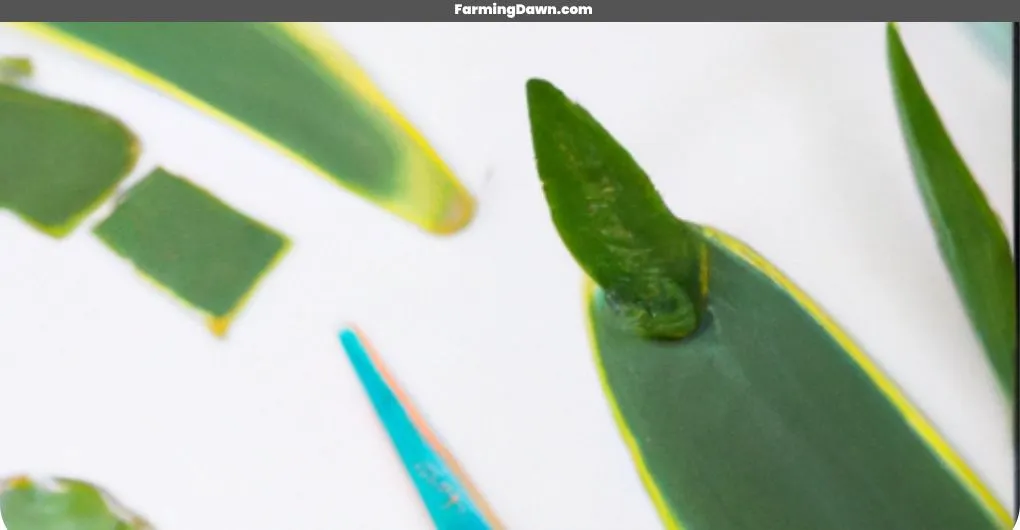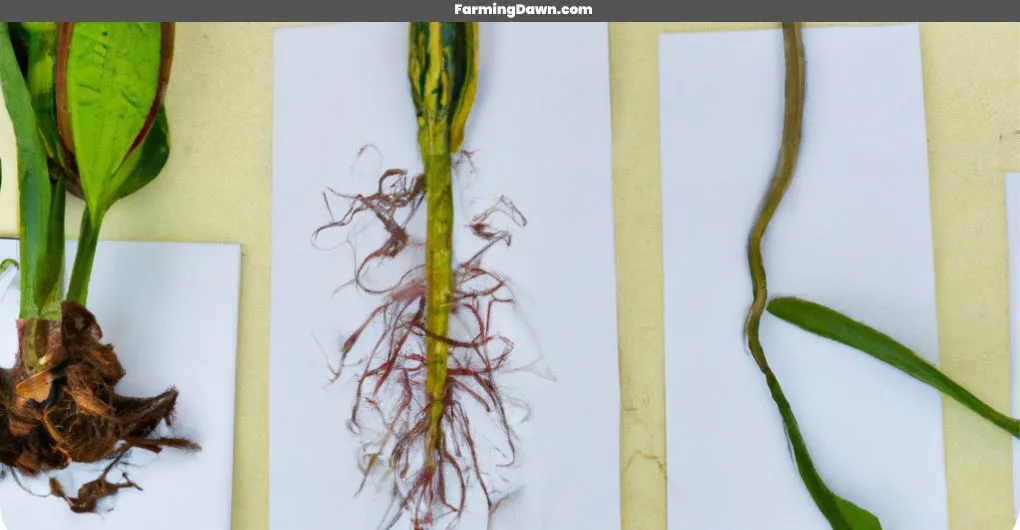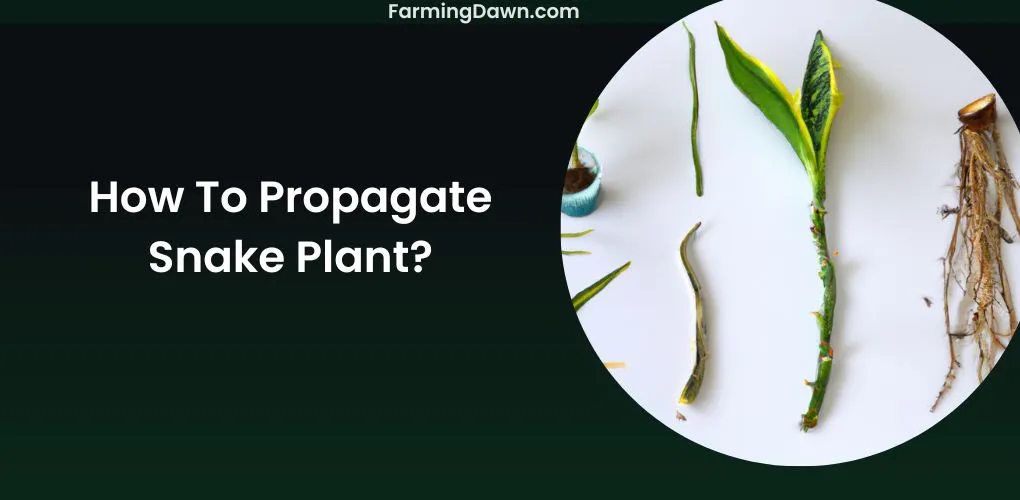We love snake plants! These beautiful and hardy plants are easy to propagate in a variety of ways. Whether you’re looking to expand your collection of these unique houseplants or just want to give them as gifts, I have all the information you need for propagating snake plants in five different ways.
In this article, I’ll explain how to propagate snake plant with division, air layering, stem cuttings, leaf cuttings, and rhizome cuttings. I’ll also share tips on how long it takes for propagation and tell you when it’s best to repot or replant a broken leaf.
Let’s dive right into it – propagating snake plants is a fun way to get creative and bring some new life into your home!
How to Propagate Snake Plant from Division?
Propagating snake plants by division is an innovative way to get more plants in the same space, as you can literally divide one bigger plant into multiple smaller ones. However, there is a risk that the division process may damage the roots of the plant, so it should be done with care.
Here is a step-by-step guide to propagating through division:
- Choose a mature snake plant, take it out of the pot, and carefully shake the extra soil off to show the rhizomes.
- Determine any parts or natural divisions that have their own roots and leaves. To divide these chunks into distinct portions, use a sharp knife or garden shears.
- Trim any broken or diseased parts from the divisions, being sure to make precise cuts.
- Each division should be planted at a depth comparable to its initial planting depth in separate pots filled with well-draining soil. Backfill the soil around the roots and lightly water to settle the soil.
- Sparingly water the newly potted divisions, allowing the soil to dry between applications, and place them in a location with bright, indirect light. Monitor their growth and provide ongoing care as needed.
Now that you know propagation through division, I would suggest you learn propagation of ZZ plant through division.
Pros of Propagating Through Division
Divide and conquer! Splitting up your snake plant is a great way to quickly expand your greenery collection. Propagating through division has many advantages, such as:
- It enables faster root growth.
- Allows you to easily customize the soil types for each individual plant.
- It saves time and money.
- Promote healthy ecosystems by providing additional habitats for pollinators like bees or butterflies.
Cons of Propagating Through Division
Splitting up your snake plant can be tricky – have you ever wondered what could go wrong? While it’s a great way to quickly expand your greenery collection, propagating through division also comes with a few cons.
- It is difficult to divide a larger snake plant into smaller pieces.
- It takes time and patience to find the right spot between two shoots or leaves.
- Risk of spreading disease from one part to another.
How to Propagate Snake Plant from Air Layering?
Air layering is an innovative and ecologically sound way to propagate plants, as it creates a new plant without having to provide extra care to the plant. Here is a step by step instructions to propagate snake plants through air layering:
- Select the stem: On the snake plant, choose a strong, mature stem where you wish to start a new plant. Cut a tiny hole through the stem’s center.
- Place the sphagnum moss: Place moist sphagnum moss around the incision and secure it in place. To make the moss’ habitat humid, cover it with plastic wrap or cling film.
- Moisten the moss: Make sure the moss is kept wet by routinely checking the air layer. Using water to mist it is optional.
- Cut the stem: Roots should start to appear in the moss after a few weeks to a few months. Cut the stem below the air layer after the roots have taken a firm hold.
- Provide sunlight: Place the root portion in a different container with soil that drains properly. Place it in an area with indirect light and lightly water it.
This method has several advantages, such as avoiding the need for rooting hormones and being able to transfer mature plants with larger root systems than those obtained through division. However, air layering can also be more difficult for inexperienced gardeners and requires some knowledge of proper technique.
See more: How to propagate jade plant?
Pros of Propagating from Air Layering
Air layering has many benefits, such as:
- It allows us to create new plants without the hassle of dividing or splitting.
- It also promotes faster growth than other methods of propagation.
- It allows us to be innovative with our green thumb skills while caring for our environment in a sustainable way.
Cons of Propagating from Air Layering
Although propagating snake plants by air layering can be a great way to get new plants for free, there are some downsides that should be taken into consideration.
- It requires specific air humidity needs in order to work properly and produce good results.
- If done incorrectly or without adequate root care, the newly formed roots may fail to thrive and cause the entire cutting to die off.
- It requires a considerable amount of time investment.
With any form of propagation, it’s always important to research and understand what goes into each step in order for it to be successful.
How to Propagate Snake Plant from Stem Cuttings?
When it comes to stem cuttings there are two ways to propagate your snake plant through stem cuttings. There are:
- Propagating snake plants from stem cuttings in water.
- Propagating snake plants from stem cuttings in soil.
Also learn: How to cut rosemary so it keeps growing?

Propagating from Stem Cuttings in water
Propagating a snake plant from stem cuttings in water is one method of multiplying the plant. To achieve success and maximize growth, it’s important to understand the timing for cutting the stem, as well as how to maintain the water environment during this process.
- Choose stems: For best results, choose healthy stems that are about four inches long with several leaves on each side of the node.
- Timing: Time your cuttings just before or during new growth periods in spring or summer when humidity levels are higher and more conducive to successful propagation.
- Remove lower leaves: Before you place the stems into their water-filled jars, remove any lower leaves that may be submerged beneath.
- Maintain water level: Keep an eye on your jar’s water level and ensure it doesn’t ever dry out entirely; top it up every few days if necessary and change out the liquid completely every couple of weeks or so.
Propagating from Stem Cuttings in soil
Here is a step-by-step guide to propagating in soil:
- Soil and container: You will need a suitable soil mix and a potting container. The soil should be well-draining and contain organic matter such as peat moss or compost.
- Add perlite (optional): You can also add perlite or vermiculite for extra drainage.
- Place the stem cutting: Once you have your potting container filled with the appropriate soil mix, place your stem cutting into it.
- Press the soil surface: Lightly press down on the surface of the soil to ensure good contact between the roots and the soil.
- Watering: Water thoroughly until water runs out of the bottom of the potting container.
- Provide sunlight: Place your newly potted snake plant in a warm spot with indirect sunlight and keep it moist but not soggy.
Pros of Propagating from Stem Cuttings
The following are the pros of the propagation of snake plants through stem cutting:
- It is an ecological, innovative process.
- It’s a great way to expand your indoor or outdoor garden selection.
- It ensures optimal health for our new plants.
Cons of Propagating from Stem Cuttings
Gain the satisfaction of multiplying your greenery, but be aware that propagating a snake plant from stem cuttings comes with its risks – don’t let it bite you!
- Stem cutting can encounter irreversible damage.
- Risk of disease or damage to the plant.
- Stem cuttings may require more maintenance than other propagation methods.
- It requires more time investment.
How to Propagate Snake Plant from Leaf Cuttings?
Propagating snake plants from leaf cuttings is a great way to create new, healthy plants. It’s relatively easy to do in both water and soil, but it does come with its pros and cons. Let’s discuss each step in detail.

Propagating Leaf Cuttings in Water
You can easily create more of this beautiful plant by taking leaf cuttings and placing them in water – it’s that simple!
- Select and cut the leaf: Chop a healthy snake plant leaf into many portions, each measuring around 2-3 inches long. Make sure each cutting has a tiny bit of the leaf base and a portion of the leaf blade.
- Place the leaf: Place the leaf trimmings in a water-filled container, being sure to keep the cut ends buried and the leaf section above the water line.
- Provide sunlight: Put the container somewhere where there is plenty of indirect light. Avoid direct sunlight since it might harm your skin.
- Maintain watering frequency: To avoid stagnation and maintain an adequate quantity of oxygen, change the water often, such as every few days or when it starts to look murky.
- Transfer the cutting: After a few weeks, the leaf cuttings’ submerged section will begin to produce roots. Transfer the cuttings to individual pots with well-draining soil after the roots are well-established.
Propagating Leaf Cuttings in Soil
We’ve already discussed one way to propagate a snake plant – growing from leaf cuttings in water. Now, let’s explore another option – propagating your snake plant from leaf cuttings in soil.
- Select leaves: To get started, you’ll need to select individual leaves that are the right size for planting.
- Prepare a potting mix: Once you have the right-sized leaves, prepare a potting mix that is well-draining and contains plenty of organic matter.
- Watering: Water your mix just enough so that it holds together nicely but isn’t soggy.
- Press the leaf-cutting: Then, gently press each leaf-cutting into the mix and lightly mist with water to ensure they make good contact with the soil mixture.
- Water regularly: Maintain regular watering until roots form – usually within 4 weeks – then reduce the amount of water as needed and enjoy watching your new plants grow!
Pros of Propagating from Leaf Cuttings
I love propagating snake plants from leaf cuttings! Here are a few pros for this process:
- It’s relatively easy to do.
- This is an excellent way to increase your collection without too much hassle.
Cons of Propagating from Leaf Cuttings
Though propagating snake plants from leaf cuttings is relatively easy, there are still a few potential pitfalls to keep in mind.
- The viability of the leaf-cutting can be unpredictable and success rates vary widely.
- Propagation from leaf cuttings can be more difficult than other methods such as division or stem cuttings.
- It has a slow growth rate.
How to Propagate Snake Plant from Rhizome Cuttings?
Rhizome cuttings are a great way to propagate the plant quickly and economically, as all you need are the rhizomes of existing plants. Here is a step by step instructions to propagate snake plants through rhizome cuttings:
- Select the plant: Choose a healthy snake plant, then locate a good rhizome for further growth. Pick a rhizome segment that has strong roots connected.
- Cut the plant: Cut a portion of the rhizome using a clean, sharp knife or garden shears, making sure it contains some roots and a few leaves.
- Use container and soil: Fill a container with dirt that drains properly. Place the rhizome cutting in the container horizontally, burying it just a little bit so that the leaves are visible.
- Watering: To help the earth settle around the cutting, softly water it. Put the pot in a spot with dappled light.
By watering sparingly and avoiding overwatering, you may keep the soil just a little bit wet. The rhizome cutting will eventually sprout new branches, demonstrating effective propagation.
Propagating snake plants from rhizome cuttings has its pros and cons. Let’s discuss this in detail.

Pros of Propagating from Rhizome Cuttings
Here are the pros:
- Splitting the rhizome gives you multiple new plants in no time.
- This method is easy for anyone to apply without any prior knowledge of propagation.
- It is also surprisingly eco-friendly.
- It allows you to reuse containers or pots that have already been used for other plants.
Cons of Propagating from Rhizome Cuttings
You may be tempted to propagate your snake plant in this way, but it isn’t without its drawbacks.
- Rhizome cutting can be difficult and time-consuming.
- The success rate of propagating from rhizome cutting is also quite low.
- There is a risk of damaging the plant or exposing it to disease-causing organisms.
For these reasons, many gardeners choose other propagation methods instead of rhizome cutting.
How Long Does It Take to Propagate Snake Plant?
Planting times vary widely depending on the method of propagation you choose, but most methods should begin to show root growth within 2-4 weeks. If you are planting from cuttings or divisions, you may see some initial growth even sooner.
For rhizome cuttings or leaf cuttings, it typically takes anywhere from 6-8 weeks for the roots to begin developing. Moreover, if you opt for air layering, you will usually expect results within a few months.
All these different propagation methods provide an ecological way to grow new plants without using any soil or water.
Is It Better to Propagate A Snake Plant in Water or Soil?
Now that we’ve discussed how long it takes to propagate snake plants, let’s explore the best-growing mediums for propagation. Is it better to propagate a snake plant in water or soil?
The answer is: it depends on the do-it-yourself propagation method you choose! For example, if you’re looking to divide the root ball of your existing plant, then the soil is the way to go.
However, if you’re taking cuttings from an adult plant and want them to root quickly, water might be your best bet. Water soluble fertilizer can help promote faster growth as well.
Can You Replant A Broken Snake Plant Leaf?
As I told you that I’m passionate about finding innovative ways to care for our snake plants, and replanting broken leaves is a great way of doing this! I believe that it is possible to replant snake plant leaves without roots and still have them survive and thrive.
Can you replant a snake plant without roots?
Astonishingly, it’s possible to replant a snake plant without any roots – an almost impossible feat! This incredible propagation method requires minimal soil and some basic understanding of the types of soils that are available.
Planting methods vary depending on the type of soil being used; however, there are some common elements that can be found in each planting method.
- First, you’ll need to make sure that the soil is moist and well-draining.
- Further, if using a container or pot to hold your snake plant, make sure it has drainage holes to prevent root rot.
- Secondly, you’ll need to carefully select a suitable growing medium for your particular species of snake plant.
While this may seem daunting at first, once you become familiar with different types of soils and their properties, the task becomes much easier.
Finally, when propagating without roots be aware that the process carries certain risks such as disease or fungal infection which can easily kill the plant if not addressed quickly enough.
With these guidelines in mind though we can confidently say that propagating a snake plant without roots is entirely possible!
When Should I Repot My Snake Plant?
We, as snake plant owners, must act to ensure the health of our beloved plants. Repotting your snake plant is essential for its continued growth – don’t wait until it’s too late! Careful decision-making is key in determining when the time is right.
If you notice any root health problems or pest prevention issues occurring, repotting should be considered sooner rather than later. Additionally, if you find that your snake plant is growing quickly and taking up a lot more space than usual, it may be time to move into a larger pot size.
A good rule of thumb is to repot your snake plant about every 2-4 years depending on the size of the pot and how quickly your particular species grows.
When selecting a new pot, make sure there are drainage holes at the bottom and pick one that’s slightly larger than its current home as this allows enough room for future growth.
Frequently Asked Questions Related to Propagating Snake Plant
Where do you cut snake plants to propagate?
Cut a healthy leaf close to the plant’s base to use as a leaf cutting to grow snake plants. Trim the leaf into portions that are each about 2-3 inches long, being sure to leave a tiny bit of the leaf base intact in each segment.
Do snake plants self-propagate?
Snake plants cannot reproduce on their own. To reproduce and produce new plants, they need human assistance through techniques like division, leaf cuttings, or rhizome cuttings.
Do snake plants like to be crowded?
No, snake plants don’t want to be in close quarters. They need well-draining soil and like some open area for their roots to spread out. It’s preferable to provide enough space between plants because crowding can cause root rot and other problems.
Do snake plants like big or small pots?
Snake plants typically prefer smaller pots since they want to be slightly root-bound. There is ample room for development in a container that is only slightly bigger than the root system while avoiding excessive soil moisture retention.
Can I use ice cubes to water my snake plant?
It is not advised to water your snake plant with ice cubes. Water for snake plants should be kept at room temperature since ice cubes might shock the roots and perhaps harm the plant.
Conclusion
We’ve just explored five different ways to propagate snake plants. We know now that it can take anywhere from a few weeks to several months for the propagation process to be complete.
We also learned that it’s best to propagate snake plants in soil, and that broken leaves can be replanted as well! Lastly, our passion for these amazing plants drives us to repot them periodically so they can continue thriving.
By doing this, we are making sure our plant friends will have a long life full of growth and beauty. Our innovation and eco-friendly practices drive us toward success with every propagation project – we are proud of our accomplishments!
Learning the Propagation process of snake plants is just one step. Also, learn my other articles related to propagation:





